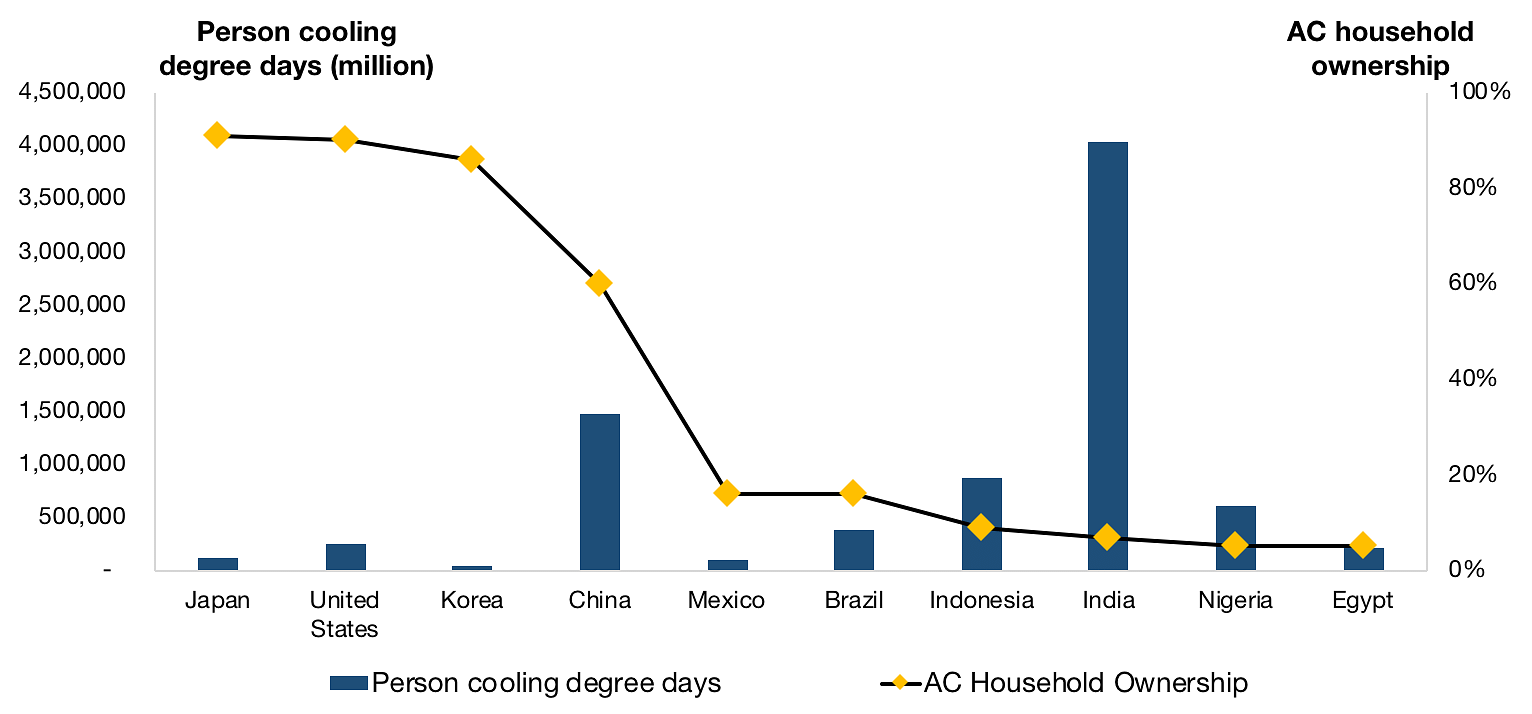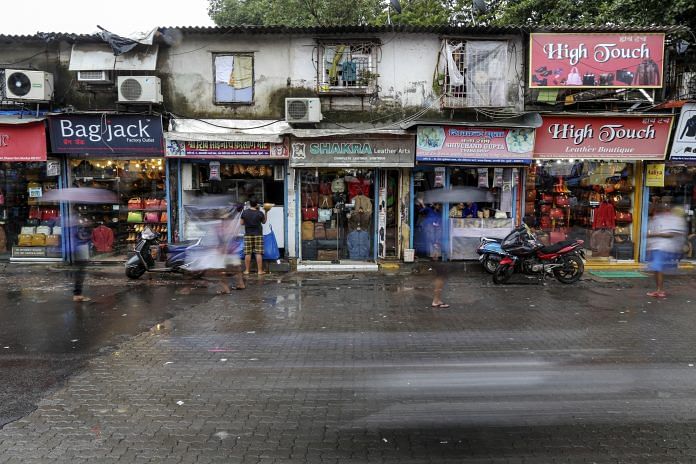Today, 40% of the world’s population resides within the hot tropical regions, where many of whom are exposed to potentially life-threatening temperatures for at least 20 days a year. Approximately 12,000 people die around the world annually due to heatwaves, and as our planet warms, these temperature surges are becoming more intense. Extreme heat often affects the most vulnerable populations, leaving them at risk. The World Health Organization estimates that, by 2050, more than 255,000 people could be killed annually from extreme heat waves.
Access to cooling can be an effective means of preventing fatalities caused by extreme heat stress – but unfortunately, people living in tropical and sub-tropical regions have dramatically lower access to cooling.
Of the 2.8 billion people living in the hottest parts of the world, only 8% currently have air conditioners (ACs), compared with 90% of people in the US and Japan. Access to cooling in many parts of the world can no longer be considered a luxury. Especially for the most vulnerable members of society, cooling access is a climate justice and equality issue. Cooling is not only important for enhancing the productivity, health and wellbeing of people but can, in some cases, be necessary for survival.
Without a doubt, access to comfort cooling is critical for many communities around the world. However, the impacts of deploying entry-level air conditioners (ACs), which typically have low upfront cost, but use highly potent refrigerants and consume a lot of energy, could possibly be one of the largest end-use risks to our climate. The direct and indirect emissions from room ACs alone could contribute to as much as a 0.5 degree Celsius increase in global warming by 2100.
India’s cooling challenge
India faces a daunting problem: how to provide access to cooling to its citizens without warming the planet. India has among the most cooling degree days in the world—more than 3,000 per year. A cooling degree day is a measurement designed to quantify the demand for energy needed to cool a building. It is the number of degrees that a day’s average temperature is above 65° Fahrenheit (18° Celsius), which is the temperature above which buildings need to be cooled. Summers in the northern and western parts of the country are already extremely hot, with average temperatures ranging from 89.6°F (32°C) to over 113°F (45°C). But the heat is getting worse every year, and these temperatures could rise by up to a further 5.4 Fahrenheit degrees (3 Celsius degrees) in many cities by 2100, which would likely result in a doubling of the number of deaths from exposure to extreme heat waves. Studies also suggest that the cost to the Indian economy due to lost productivity from extreme heat would exceed $450 billion by 2030.

With these extreme heat events, the need for access to cooling should be viewed as a basic necessity – not just for health and productivity reasons but, in some cases, even for survival. While the household ownership of ACs in India today is a mere 7%, the demand for comfort cooling is expected to drive the total stock of room ACs to over 1 billion by 2050 – a 40-fold growth from 2016. To put this in perspective, of the roughly 290 million households in India, fewer than around 20 million have ACs. Growth in the demand for cooling will be dramatic, particularly in urban areas, due to the underlying need for a solution to the problem of heat stress. Rising temperatures, population growth and urbanization are only going to worsen the problem of heat stress in cities.
And with greater development and the rise of incomes of the middle class in the country, many more people in India will make their first purchases of ACs to provide a better quality of life for their families. It is likely, though, that they will buy the lowest-priced AC units on the market, without taking into consideration the operating costs or emissions from their operation. Unfortunately, the most popular lowest-priced room AC units on the market today are inefficient and, if deployed at scale, will further burden India’s already strained electricity system. Air conditioning currently accounts for about around 40–60% of peak power demand in summers in the major Indian cities of Mumbai and New Delhi, where there is the greatest concentration of air-conditioned buildings. To operate the projected stock of room ACs in 2050, approximately 600 gigawatts of new power generation capacity would be needed – equivalent to the installation of 1,200 coal power plants of 500 megawatts each – which will require an investment of over $535 billion in new generation infrastructure.
The operation of these AC units will also have an impact on our climate. The emissions associated with their electricity consumption and refrigerants will only exacerbate the global temperature rise. Refrigerants – potent greenhouse gases – are the working fluids in an AC, which can leak during operation or get released into the atmosphere during servicing and replacement. While India contributes only 5% of the global annual emissions from room ACs today, in a business-as-usual scenario, India is predicted to account for over 25% of annual emissions globally by 2050 due to the unprecedented rise in comfort cooling demand, particularly in the residential sector.
Averting the energy crisis
The Indian government recognizes people’s need for cooling and realizes that an exponential rise in demand for cooling is inevitable, especially as such a rise is intrinsically tied to health and productivity outcomes. But it also understands the importance of meeting this need effectively and in a sustainable manner so that it does not result in runaway climate change or an energy crisis.
The government, at both the federal and state levels, is exercising political action. Ahmedabad, India, was the first city in South Asia to formulate a heat action plan after a devastating heat wave hit the city in 2010. By June 2017, 17 cities and 11 states across India had released or were developing heat action plans. In 2019, India became the first major country in the world to develop a national policy document on cooling, the India Cooling Action Plan, which provides a 20-year roadmap addressing India’s future thermal comfort and the cooling needs of its people in a sustainable manner.
To promote the adoption of more energy-efficient ACs, the Bureau of Energy Efficiency defines the minimum energy performance standards for ACs and has been raising this efficiency performance requirement at nearly 3% every year. It has also developed a star label system to help raise consumers’ awareness about room AC efficiency.
In addition, the Government of India’s energy services conglomerate, Energy Efficiency Services Limited (EESL), which was created in 2009 as a joint venture of four national public-sector undertakings, is looking to aggregate demand for superefficient room ACs leveraging economies of scale to bring first costs closer to those of the standard-efficiency ACs being sold in the market today. EESL recently announced that it is partnering with BSES, a utility in Delhi, for a 12-month pilot programme that will look at deploying ACs that are 40% more efficient than, but priced comparably to, the three-star ACs currently available in the market. The pilot programme would cater to around 2.5 million residential and institutional consumers in Delhi.
Recognizing that innovation is key to addressing India’s exponential cooling demand in a sustainable manner, the Government of India, through its Department of Science of Technology and other nodal ministries, is supporting the Global Cooling Prize. The prize envisions a “5X solution” – a cooling solution that has one-fifth of the climate impact of the commonly sold room AC units in the market today, taking into account both the grid-supplied electricity consumption and refrigerant global warming potential of the technology.
With rapid scaling and adoption of a superefficient and climate-friendly solution, India could avoid paying for nearly 400 gigawatts of new power generation capacity by 2050 – equivalent to saving nearly $380 billion, or a whopping 15% of India’s 2017 GDP. By switching its current and future room AC stock with a 5X solution, India could potentially mitigate up to 16 gigatons of cumulative carbon dioxide equivalent emissions by 2050. This emissions reduction is equivalent to reducing the emission intensity of the Indian economy by 15% by the year 2030 from the 2005 levels, which could constitute nearly 40% of India’s Nationally Determined Contribution target. Moreover, with a 5X solution, every consumer can save money by using more efficient and climate-friendly AC. That money could be used to meet the other needs of Indian households, such as access to better education for children or better healthcare services for families.
By harnessing the power of innovation, India and the world will be able to provide access to cooling to all without warming our planet. To learn more about the Global Cooling Prize, click here.
Radhika Lalit is a manager at Rocky Mountain Institute and Ankit Kalanki is an associate at the Rocky Mountain Institute.
This article was originally published in the World Economic Forum.
Also read: Indian summer monsoon amplified global warming 130,000 years ago






